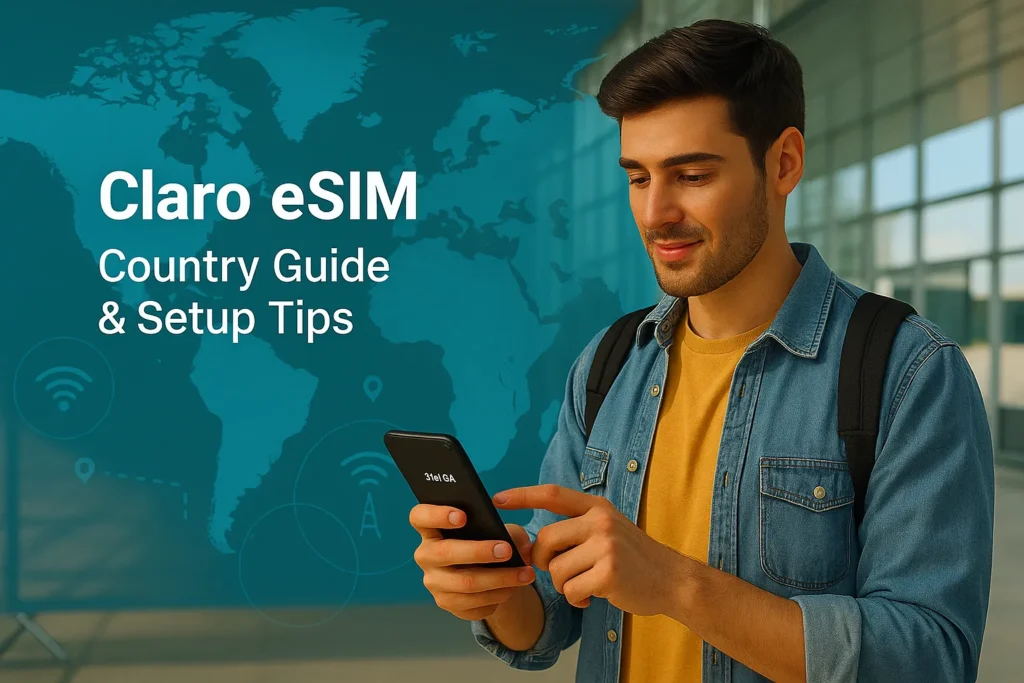Ready to Ditch Physical SIM Cards? Discover Claro’s eSIM Options Across Latin America
claro esim If you’re tired of constantly swapping SIM cards when traveling or need a second line for work or personal use, you’re not alone. The mobile industry has been rapidly evolving and one of the most exciting innovations in recent years is the eSIM. Unlike traditional SIM cards, eSIMs are built directly into your device, offering incredible convenience, flexibility, and connectivity.
At Ai eSIM, we’re experts in digital connectivity and eSIM technology. One carrier we frequently monitor is Claro, a major telecommunications provider throughout Latin America. So if you’re a current or prospective Claro customer, you may be wondering: Does Claro support eSIM?
The answer is yes, but the availability, activation process, and supported devices can vary significantly depending on the country you’re in. That’s why we’ve created this comprehensive guide—so you can understand exactly how Claro handles eSIMs in different regions like Brazil, Peru, Argentina, and beyond.

What is an eSIM and Why It’s Transforming Mobile Connectivity
An eSIM is a small chip built directly into your smartphone or tablet. Unlike a physical SIM card that you need to insert, an eSIM can be activated digitally—usually by scanning a QR code or entering carrier information manually.
Why eSIM Is a Big Deal:
- Ultimate Flexibility: Easily switch between mobile carriers without changing physical cards.
- Multiple Lines: Use multiple numbers or plans on one device—perfect for travelers or work/life balance.
- Seamless Travel: Activate local data plans instantly without searching for a SIM vendor.
- Space Saving: Eliminates the need for SIM slots, enabling sleeker device designs.
- Security: eSIMs are more secure and tamper-resistant than traditional SIM cards.
- Instant Setup: Activate service remotely, often without visiting a store.
| Feature | Traditional SIM | eSIM |
|---|---|---|
| Physical Card Required | Yes | No |
| Installation | Manual insertion | Remote download |
| Device Switching | Requires new card | Digital profile switch |
| Dual SIM Support | Two physical cards (if supported) | Multiple digital profiles |
| Setup Time | Store visit often required | Instant or app-based |
| Best For | Local users | Global users, travelers, minimalists |
Claro eSIM Availability by Country
Claro’s eSIM rollout isn’t uniform across its operating countries. Let’s explore what to expect in each major market:
Claro eSIM in Brazil
Availability: Claro Brazil supports eSIM for prepaid, postpaid, and Claro Flex plans.
How to Get It:
- In-Store: Visit a Claro store with your ID for activation.
- Online: Use the Meu Claro app or official website if you’re an existing customer.
Activation Steps:
- Get your eSIM QR code from Ai eSIM.
- On your phone, go to Settings > Cellular > Add Cellular Plan.
- Scan the QR code and follow the prompts.
Pros: Great flexibility, dual SIM support, widely available
Cons: Some users may still need in-store activation
Claro eSIM in Peru
Availability: Claro Peru also offers eSIM for prepaid and postpaid plans.
How to Get It:
- In-Store: Most common method—bring your ID to a Claro service center.
- Digital Options: Availability via app/online may be limited or evolving.
Activation Steps: Similar to Brazil—scan QR code and complete setup via phone settings.
Compatible Devices: Align with global standards (iPhone, Samsung Galaxy, Pixel, etc.)
Pros: Modern connectivity, easy travel switching
Cons: In-person visit often required for activation
Claro eSIM in Argentina
Availability: Limited. Claro Argentina does not widely offer consumer eSIMs.
Options:
- Locals: May not have access to eSIM from Claro currently.
- Travelers: Can use global travel eSIM providers (like Airalo or Holafly) that partner with Claro’s network.
Device Compatibility: Most modern eSIM-enabled devices would technically work if Claro supported it.
Pros: Potential future rollout
Cons: Not currently available for everyday users
Claro eSIM in Other Countries
- Chile: Available; in-store or digital activation may be offered
- Colombia: eSIM support available for select plans and devices
- Other regions: Status varies—check the country-specific Claro site for accurate details
💡 Pro Tip: Use the search terms “eSIM,” “chip virtual,” or “SIM digital” on Claro’s website for your country.
eSIM Options for Travelers
Whether you’re using Claro or a third-party provider, eSIM is a game-changer for international travelers.
Scenario 1: Using Claro Abroad
If you already have a Claro eSIM from Brazil or Peru, you can roam internationally—but check roaming rates or buy an add-on package beforehand.
Scenario 2: Visiting a Claro Country
Instead of buying a local SIM, consider a travel eSIM from providers like Airalo, Holafly, or Nomad. These use Claro’s local network (where available), providing data access without the hassle.
Benefits:
- Purchase and activate before your trip
- Use data on arrival
- Keep your home SIM active for calls/texts
💡 Note: These providers operate independently of Claro, so customer support comes from them not Claro.
Troubleshooting Claro eSIM
Common Issues & Fixes:
- QR Code Won’t Scan: Try better lighting or a different screen. Request manual activation info if needed.
- Activation Fails: Check Wi-Fi connection and ensure the QR code hasn’t expired.
- No Signal After Setup: Toggle eSIM on, check APN settings, restart the phone.
Lost or New Device?
- You may need a new QR code from Claro
- Use Apple or Android transfer features if supported
Final Thoughts
Claro’s adoption of eSIM technology is growing across Latin America, especially in Brazil and Peru. With the right device and a bit of prep, switching to or activating a Claro eSIM can offer major benefits—whether you’re at home or traveling.
Stay informed by checking your country’s official Claro website for the latest updates, and enjoy the freedom and flexibility of modern mobile connectivity.



